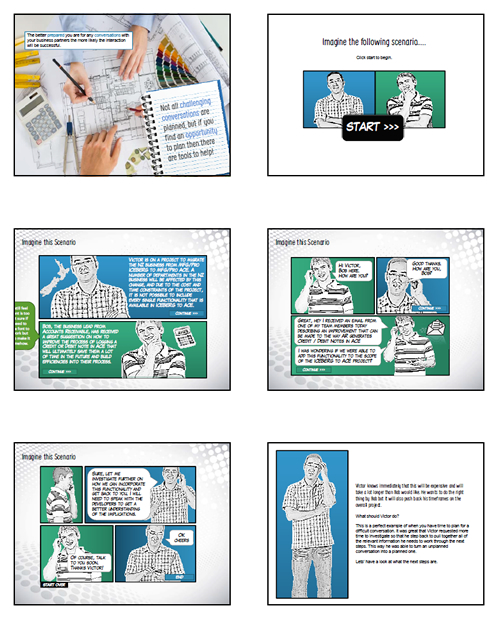
One of the fundamental things drummed into people who have embarked down the path of the eLearning developer is the need to start your development project with a detailed and well planned storyboard. From this your content can be planned, screens can be devised, interactions envisaged and source material can be sculpted so as to reduce cognitive load and therefore improve knowledge transfer and/or application.
The development of a storyboard is seen as a fundamental task which takes time to get right and can make or break the content for the audience and the designer. eLearning has certainly followed through with this belief in the compulsory nature of the storyboard, making it a standard line item on any build estimate.
However I question this logic. Is a storyboard required for all content development? Especially in the light of today’s amazing content development tools, such as Articulate Storyline, do we really need to build a complete static plan for the content under development, or can we just go straight to building direct from the source materials?
To me this approach makes perfect sense for a number of reasons:
- It cuts down on the overall project time. If you storyboard content into PowerPoint, you still have to develop all of the content slides, mock up the interactions and re-engineer the text and audio to work for an online audience. Then once you have sign off you have to rebuild all of the same screens again. (A bit like double handling).
- It lets the client see a living and breathing version of the content at the first review.
- With a storyboard, you may have 2 or more review cycles prior to commencing a build and even once it is signed off and the first actual content version is delivered things can still be lost in translation, where reviewers are unable to imagine interactivities until they actually see them working.
- Source materials are often highly dynamic in their actual content, most due to normal business pressures when policies, wording, branding and even SME subjectivity can change on a week by week basis. In such an environment a project may spend weeks or months in a constant revolving feedback loop before it can even be signed off.
- Screen design can be signed off much more efficiently. By showing a client a branded set of indicative content slides, built from their own source materials and including intended interactions allows the client reviewers to judge the content and interactive design based on a tangible output.
- It saves the client money. Bottom line is that it is faster to develop initially and much quicker and easier to review and these factors together mean that the client still gets the same great output at up to half the cost.
Now before eLearning designers and developers light their flaming brands, take up their pitchforks and form a ravening mob out for justice, please let me say that storyboarding is a fundamental tool for the development of eLearning and there are times when it is not just beneficial but also crucial.
Getting a quality eLearning outcome with any of the following would be either very difficult to near impossible without a storyboard:
- When building a complex branching scenario when user decisions can lead them through a complex path in the content and when decision feedback and consequences can be felt at any stage of the content journey
- When there are custom design elements that require several iterations
- When the source material provided is provided in such a technical format that time needs to be spent with the SME to de-code it then to reconstruct it in eLearning appropriate format. Mostly so that the SME can see how the information flows and links.
- Where the navigational elements of the course allow the learners to select multiple paths through the content to reach a common goal.
Lion Co required an extensive branched scenario using a comic style design theme to show their team how to have successful challenging conversations. The solution was to storyboard in Microsoft Powerpoint which allowed for a fast and effective client review of the content (they made changes to the conversation transcript themselves and text) and then we simply imported the file into Articulate Storyline to build the course. But, how often really are courses like this developed? We estimate around three projects in every ten.

B Online Learning develops all of our client’s content to their exact specifications, where that includes storyboard development or not. What we always do when commencing a development project is to give the client an honest appraisal of what is actually required. For us it’s all about what is the best possible solution, not just ticking the boxes and racking up the invoice line items.
